
Alberta Wildlife Photography
by Dr. Robert Berdan
August 31, 2019

Swift fox photographed at the Cochrane Ecological Reserve in Winter. Nikon 300 mm F2.8 lens.
I have lived and photographed in Alberta for over 30 years. I have also crossed Canada and travelled into the Arctic to photograph wildlife and the Aurora Borealis. Alberta is one of the best provinces in which to photograph wildlife, in part because it has many different habitats including the Rocky Mountains, prairies, foothills, aspen parkland, badlands and boreal forest. It is also not densely populated with people.

Map of Alberta - some photo hot spots are marked in red text
Alberta borders with Montana to the south on the 49 parallel and the Northwest territories at 60° North. The province is land-locked and hosts Canada's largest oil fields. The population is just over 4 million with an area of 660,000 square kilometers. It's two main cities are Edmonton (capital) and Calgary which both have over 1 million people. You don't have to travel far outside the major cities to photograph a wide variety of birds and mammals.

Coyote photographed next to the road north of Calgary. Most coyotes run away as soon as I open my car door, this one might be a wolf-coyote hybrid and stared me down. Nikon 500 mm F4 lens.

Frightened fawn. I was walking along the Elbow river near Bragg Creek with my 300 mm lens and camera in hand. This fawn was hiding in some low grass and when I walked next to him, he jumped up and ran. By reflex I pulled my camera up and I took a burst of photos. It was an overcast day so I had my ISO speed set high. I was lucky to get about 3 sharp photos all taken at 1\2000 of a second.
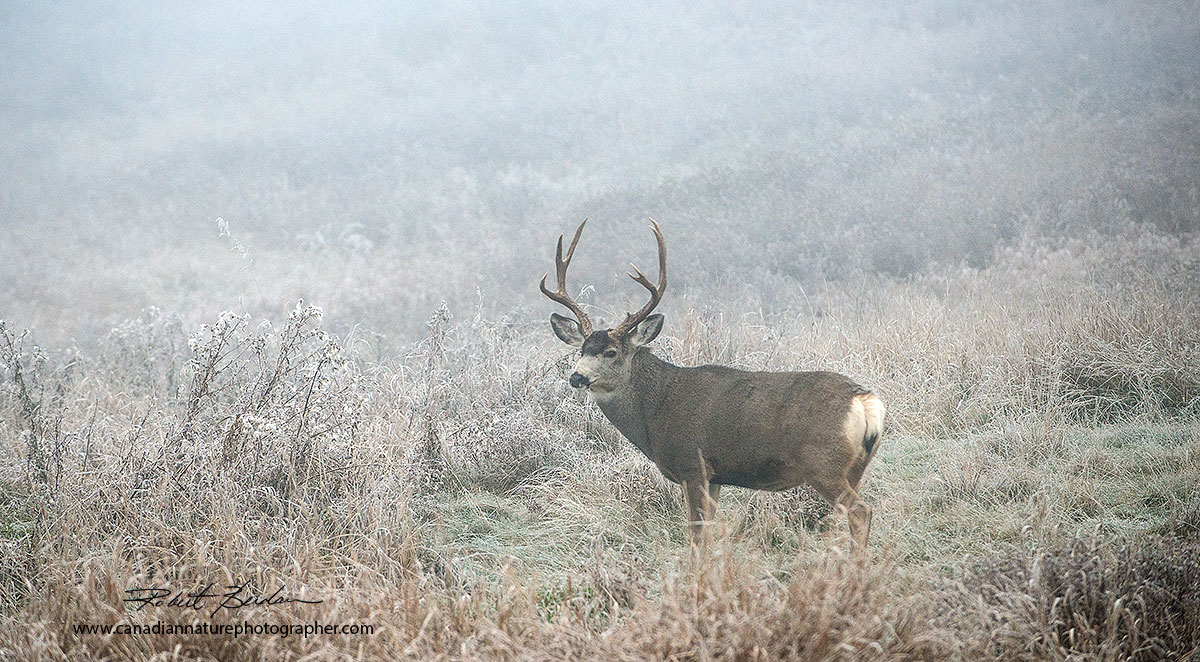
Late October early November is a great time to photograph Mule deer during the autumn rut in Fish creek Park. I went with friend and fellow photographer Dr. Wayne Lynch and we arrived early about 5 am. This amazing park is in the heart of the Calgary, but with the fog you couldn't tell you were in the city. The animals are habituated to people and allow you to approach them more closely then otherwise.
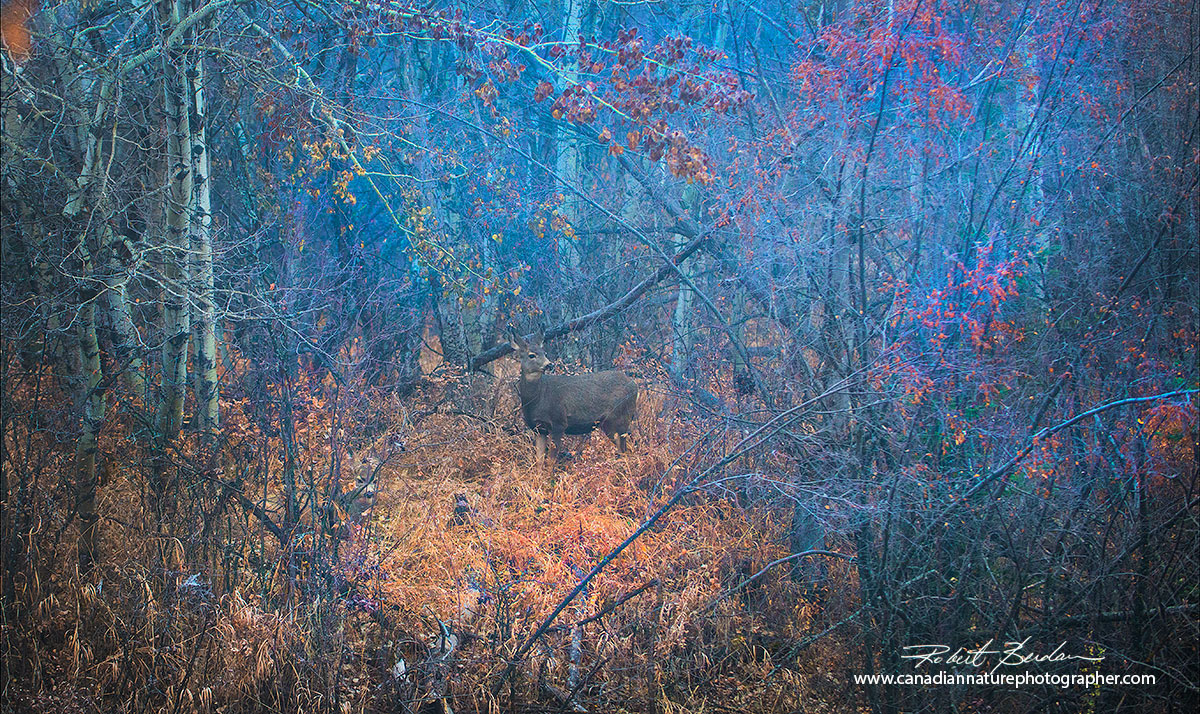
The above photo was also taken in Fish Creek Park in Calgary on the same morning. I was attracted to the chaos, fog and subtle colours. There are two deer in this photo - can you find the other one? Nikon 70-200 mm F2.8 lens.

Who doesn't love turkeys? These were photographed in the foothills near Millarville. When I saw them in the ravine, I stopped the car to get out and they all came over to me and surrounded me. Clearly somebody had been feeding them. Nikon 70-200 mm F2.8 lens.

I found a den of baby red foxes near Airdrie while driving to Red Deer one morning. Although foxes are common they are not easy to find and photograph as they often hunt at night. Nikon 300 mm F2.8.

Red Fox "mom" watching over her babies above. Frame grab from HD video.
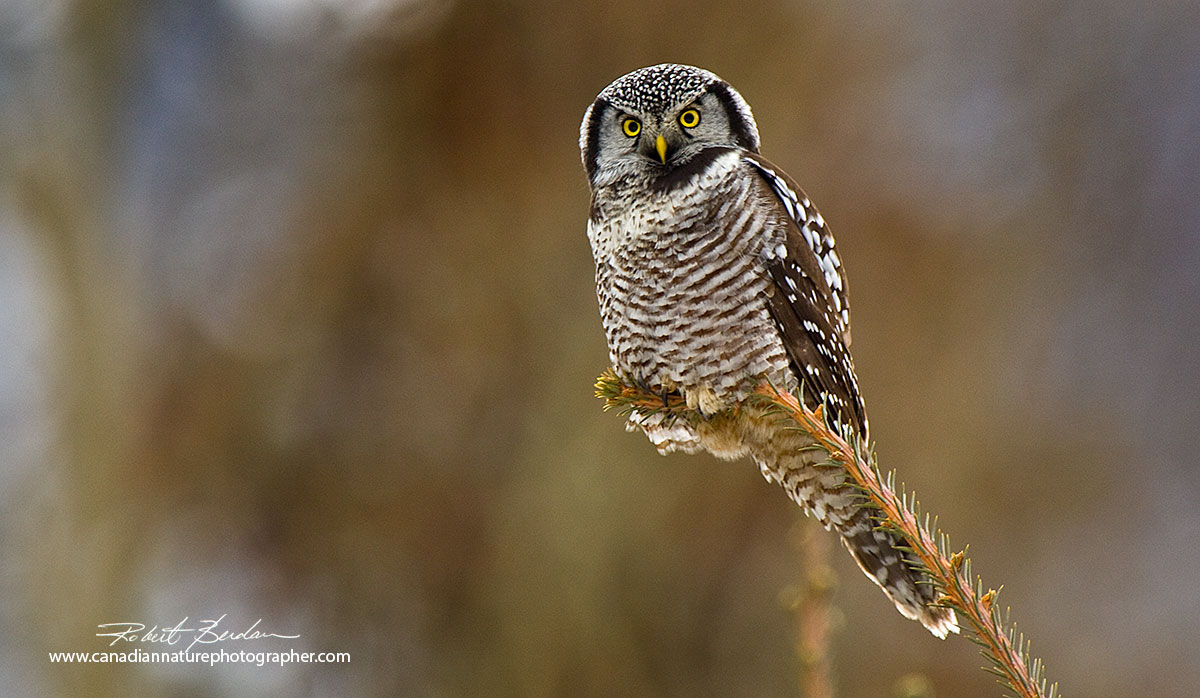
Northern Hawk Owl photographed along highway 1A in Banff National Park. I had a group of photographers with me and this owl posed for us for about 15 minutes - long enough for me to set up my tripod. Nikon 300 mm F2.8 lens.

Short-eared Owl next to Grande Valley Road west of Cochrane. Nikon 70-200 mm F2.8 lens.

Great Horned Owls are present in Alberta all year long this one was photographed south of Mossleigh. What makes these owls difficult to find is that they are almost perfectly camouflaged. Nikon 500 mm F4 lens.
From a photographers point of view the diversity of habitats and the relatively low population in Alberta means wildlife are still abundant. Some animals of course are at risk, threatened or endangered (e.g. Grizzly bear, burrowing owl, Peregrine falcon, Great plains toad, Sage grouse, Swift fox, Prairie Rattlesnake etc - see species at risk website in Alberta).

Young Burrowing owls near Brooks, AB. Friend and fellow photographer, Dr. Wayne Lynch shared this sighting with me and Dr. Sharif Galal. Burrowing owls are endangered in Alberta and difficult to find. Nikon 500 mm F4 lens.

Northern Saw-whet Owl in Kananaskis. I was able to photograph this owl with friend and fellow bird photographer Alan Mckeigan. Alan played a Saw-whet Owl recording and to my astonishment this owl landed right in front of us. Nikon 300 mm F2.8 lens.

Great Gray Owl photographed in flight during snowfall. Nikon 300 mm F2.8 lens and a Nikon D500. This photograph was taken in the foothills north-west of Cochrane on Grande valley road.

Great Gray Owl diving for a vole. Catching these birds in flight requires a fast shutter speed, quick autofocus lens and anticipation. Owls will lift their shoulders when they are about to take off. Snowy owls often defecate and then fly off. By watching the owls behaviour you can often anticipate when they will take off and then you can begin to shoot a burst of photos. Nikon 300 mm F2.8 lens.
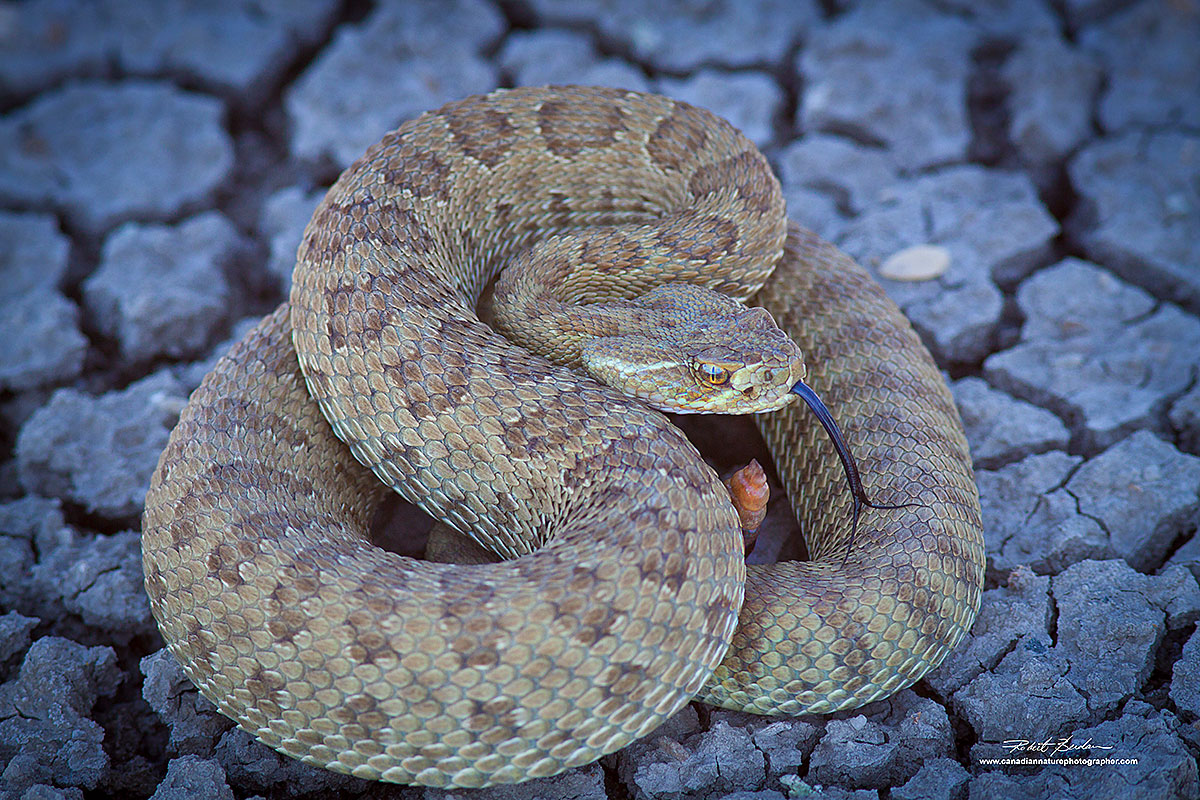
Prairie rattlesnake photographed in Red Rock Coulée in south east Alberta. Nikon 100 mm macro lens. I photographed this snake with friend and fellow photographer Hälle Flygare from Canmore. I had actually stepped over the snake without seeing him, but Hälle had walking poles and noticed him immediately. This snake was not aggressive, lucky for me I did not step on him.

Hoary marmots are usually seen at higher altitudes in the mountains among the rocks and can sometimes be seen wresting with other marmots. I have also seen them along the Sibbald creek road into Kananaskis. Nikon 300 mm F2.8 lens.
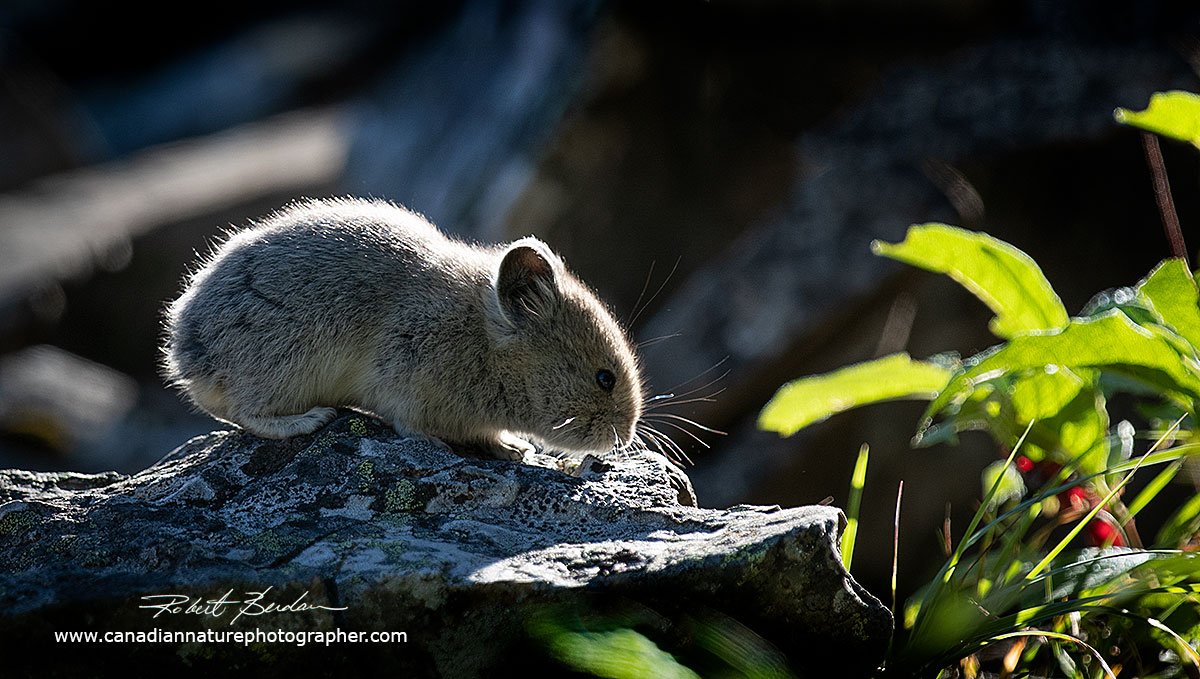
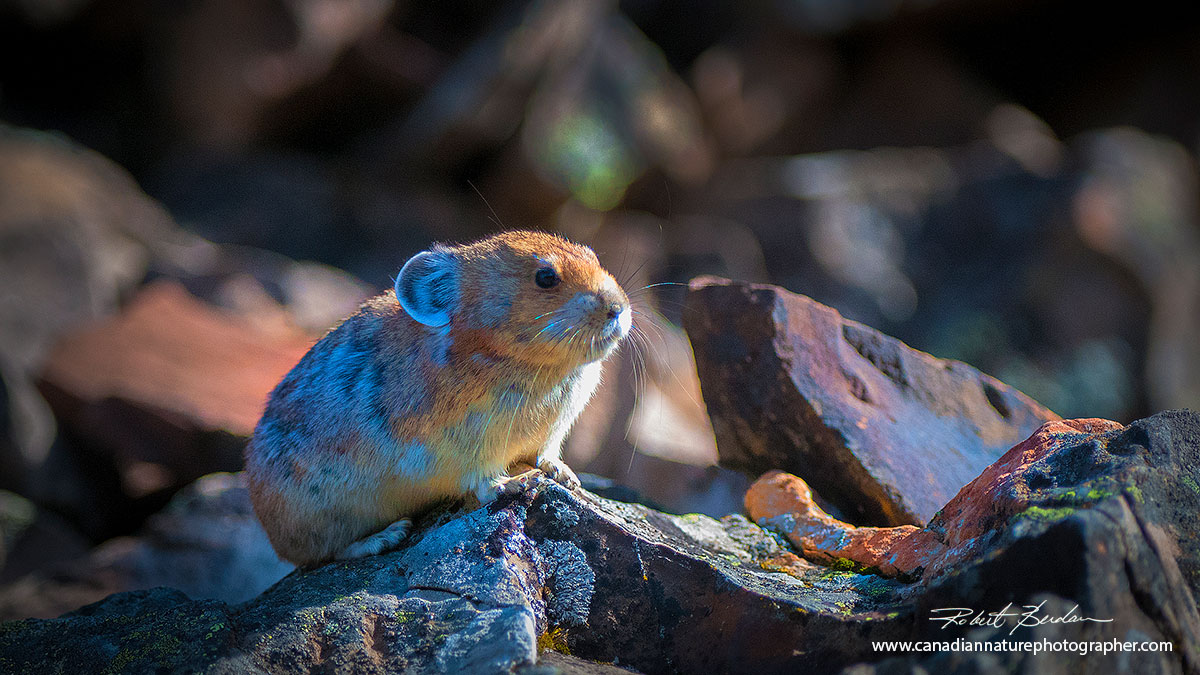
Above two photos of a Pika, also called a "Rock Rabbit". Pikas are common at the Rock slide in Kananaskis. These small mammals are fun to watch and make a high-pitched "peek peek" sound. I almost always see them at the Rock slide gathering plants for winter.
I take folks out to see and photograph wildlife, but no photographer or guide can guarantee particular animals unless they bait or have access to restricted areas. Baiting is not allowed in parks and I have not seen a need to do it. I have always been able to find deer and a variety of birds in all seasons. In some places like Kananaskis, I see moose and mountain sheep about 50% of the time. I encounter grizzly bears about 25% of the time when they are not hibernating. Other large game that is common include Elk. Mountain goats can be seen along the drive to Jasper National Park or Emerald lake in BC. I have photographed wolves and cougar in the Mountain National Parks, but they are a very rare treat.

Mountain goat and kid. Goats are sometimes seen next to the highway from Banff to Jasper. Nikon 70-200 mm F2.8 lens.
Owls are common in the foothills and I will see one in about every 3 or 4 trips. Some years the owls are more abundant. Snowy owls come south in winter and arrive around the Calgary area beginning of November and stay until the end of February or middle of March. Snowy owls are easier to find then other owls and tend to be more reliable in part because they are found on the prairies and often perch on telephone poles or fence posts making them easier to spot.
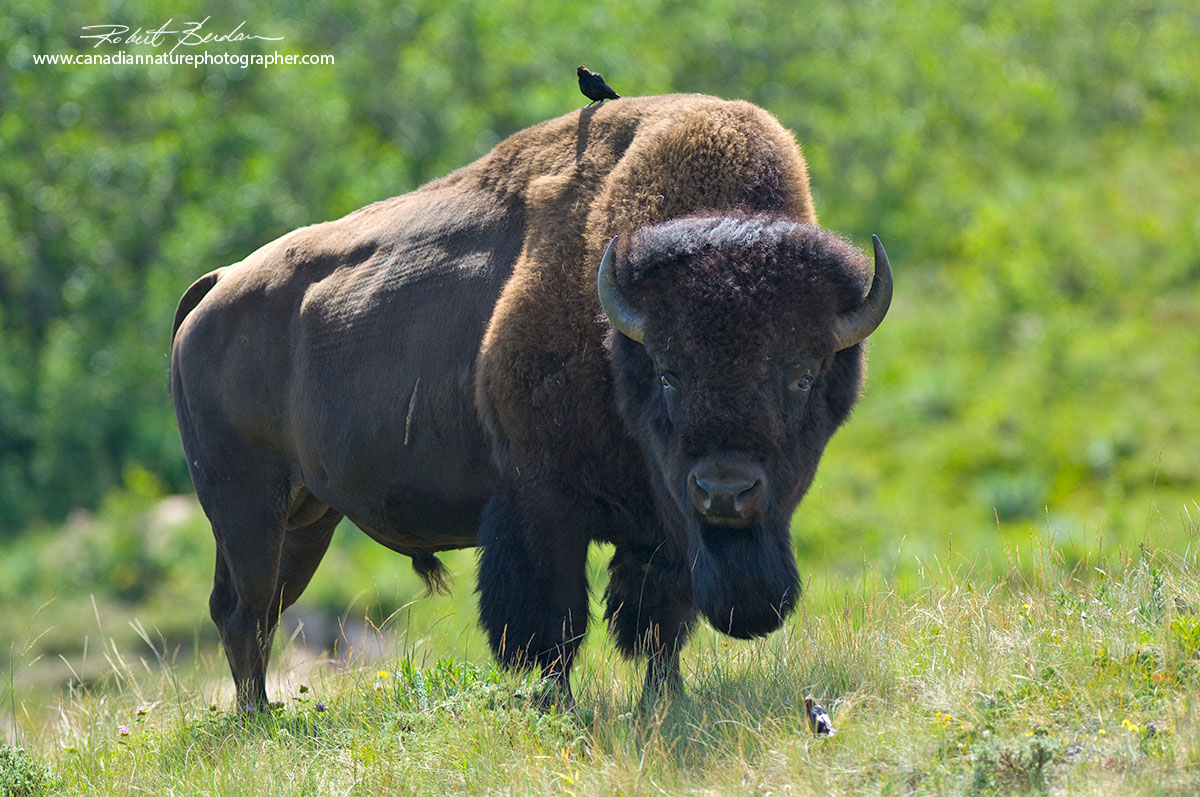
Bison photographed in a paddock just outside Waterton national park from my car. Bison were recently introduced to Banff National Park. Nikon 300 mm F2.8 lens. This is a sunny day photo from my car window.
What is the Best season to photograph wildlife?
The best season really depends on what you want to photograph. Snowy owls December to Feb are best. Grizzly bears from May to October. Deer, Elk and moose are around all year long, but they look their best in their autumn coats. Many birds migrate through Alberta starting in March until about October e.g. Waterfowl and White-faced ibis. Other birds like eagles, tundra-swans and trumpeter swans migrate through Alberta starting in March but the marjority are gone by mid April. If you visit Alberta the best season will depend on what you are hoping to see and photograph. In the summers the national parks are crowded and I try to avoid them at that time.
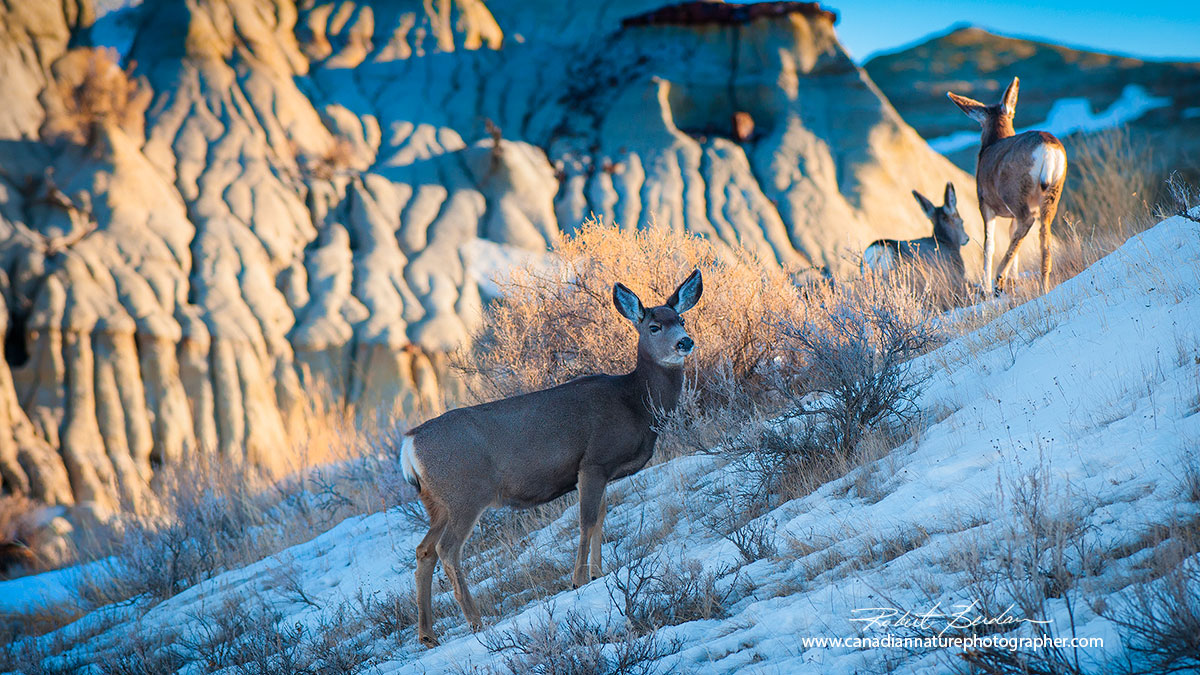
Mule deer in winter at Dinosaur Provincial Park near Brooks, AB. Nikon 70-200 mm lens.

Elk are common along Highway 1A in Banff National Park and in Kananaskis. These Elk were photographed in autumn in the Hillsdale meadows. Nikon 300 mm F2.8

Mountain Sheep photographed along the David Thompson Highway. Nikon 70-200 mm lens.
Is there a best time of Day to photograph wildlife?
In my experience the best time to photograph most wildlife is early morning or late in the day from about 6 pm on. In the middle of the day many of the animals are either in the bush or resting in the shade. In winter animals can be seen at any time of day though the light tends to be better for photography in the morning and later in the day.

Two mule deer bucks putting on a show for a female next to Bears paw road just north of Calgary. The reason I headed out that morning was because of the rime on the tree branches. Nikon 300 mm F2.8 lens.
Risks
Ticks, mosquitos, Giardiasis (beaver fever), bears, cougars, Elk, Goats and Mountain Sheep during rutting season can all be a danger. In summer you may encounter bears on trails so it is important to travel in groups and bring bear spray. During wind storms trees have blown down and killed children so you need to be careful when travelling in forested regions. Streams and rivers in Alberta can be very cold and some of them have strong currents. Rock and ice climbing have their own special risks, so if you are not familiar with the terrain you should hire a guide. If you intend to hike into the back country tell someone where you are going and when you expect to be back. If you have been travelling in areas with lots of deer and big horn sheep, check for Ticks at the end of the day. Ticks can attach to your camera bag and clothing, they climb up into your hair and then bite you while you are sleeping. They can cause Rocky Mountain spotted fever and if you have been bitten see a doctor who will likely put you on antibiotics. I have been bitten, you don't feel anything, but seeing one embedded in your skin is disturbing.


I have only had one chance to photograph a wild cougar. I photographed this one in Waterton National Park next to the road. At first I thought he was a deer, I jumped out of my jeep with camera and lens and he turned around and sat down. I moved toward him slowly as he watched me and then I began to think about what I was doing and backed up. He might of thought dinner was coming to him. Cougars have been seen in the Waterton town site and their is a stuffed one at the Bayshore Inn lobby that wandered into town and hid under bus.
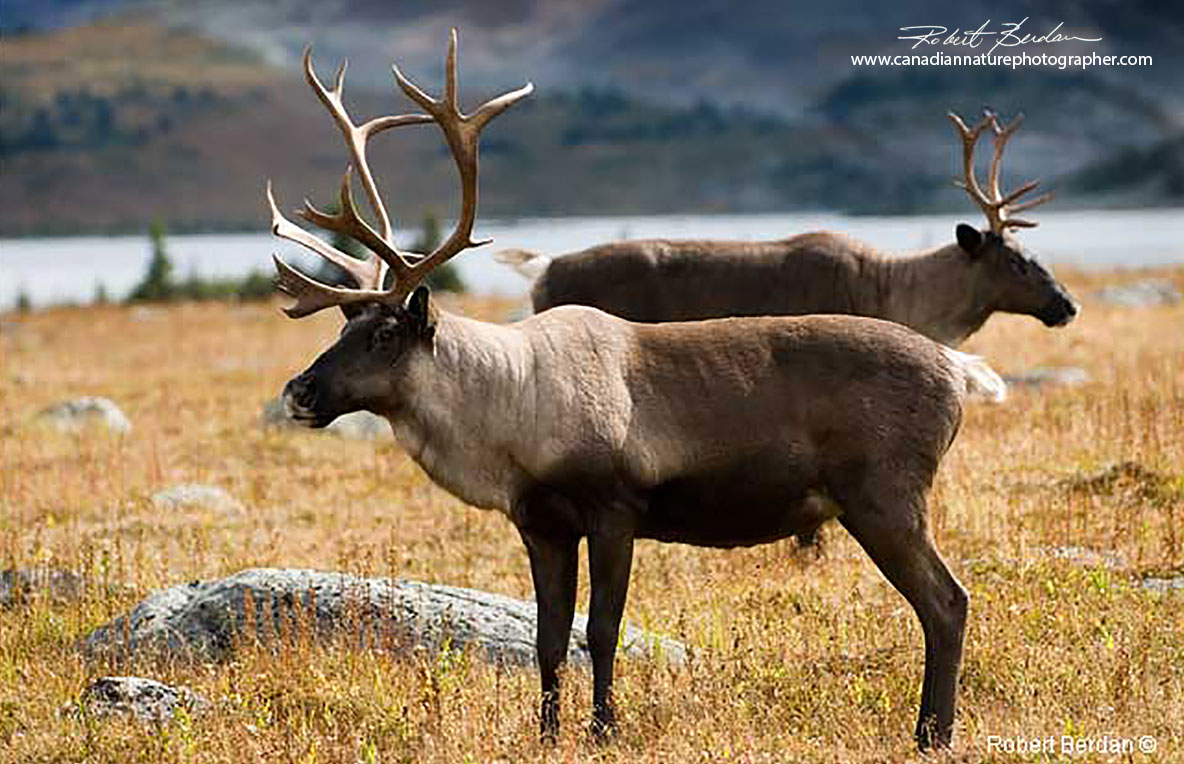
Another animal that is getting harder to photograph are Mountain or Woodland Caribou. These were photographed in the Tonquin Valley in Jasper National Park. Nikon 70-200 mm lens.
Photography Guides
If you are coming to Alberta research the web, get a hold of some topo maps, park maps, and if visiting the mountains parks there are a large number of trail guides and books you can purchase which describe describe and show what you might see. You can also hire guides - there a large number of them - myself included. Guides can take you to places to increase your chances of seeing what it is you are looking for and if you have more time you can then explore by yourself. The main attractions; Banff, Lake Louise, Moraine lake, Bow Lake, Peyto Lake, Jasper and Drumheller are easy to find yourself as they are on the main highways.
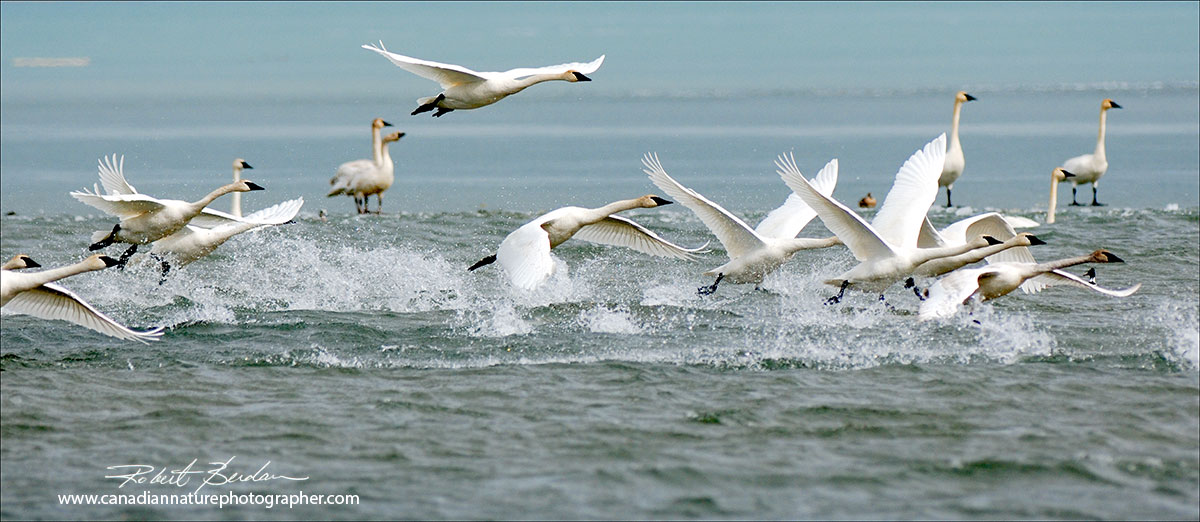
Tundra Swans on the Bow reservoir in mid March. There was still ice on the reservoir you can see a few of the swans standing in the background. When I approached the birds too closely they took off. Nikon 300 mm F2.8 lens.

Pelicans are seen in summer around the Bow river, Carseland Park and in marshes around Brooks, Alberta. Nikon 300 mm F2.8 lens.

Black-necked Stilt photographed east of Calgary. Nikon 500 mm F4 lens.

American Avocet catching a small fish at Weed Lake east of Calgary. Nikon 300 mm F2.8 lens.

Common snipe. These birds make unusual sounds when courting in the Spring - a "who who" like sound when flying called Winnowing - listen to the sound in this YouTube video. They are common around marshes on the prairies and in the foothills. Nikon 500 mm F4 lens.

Greater Yellowlegs east of Calgary. Nikon 500 mm F4 lens.

Black-crowned night heron. Photographed off the highway near Frank Lake.
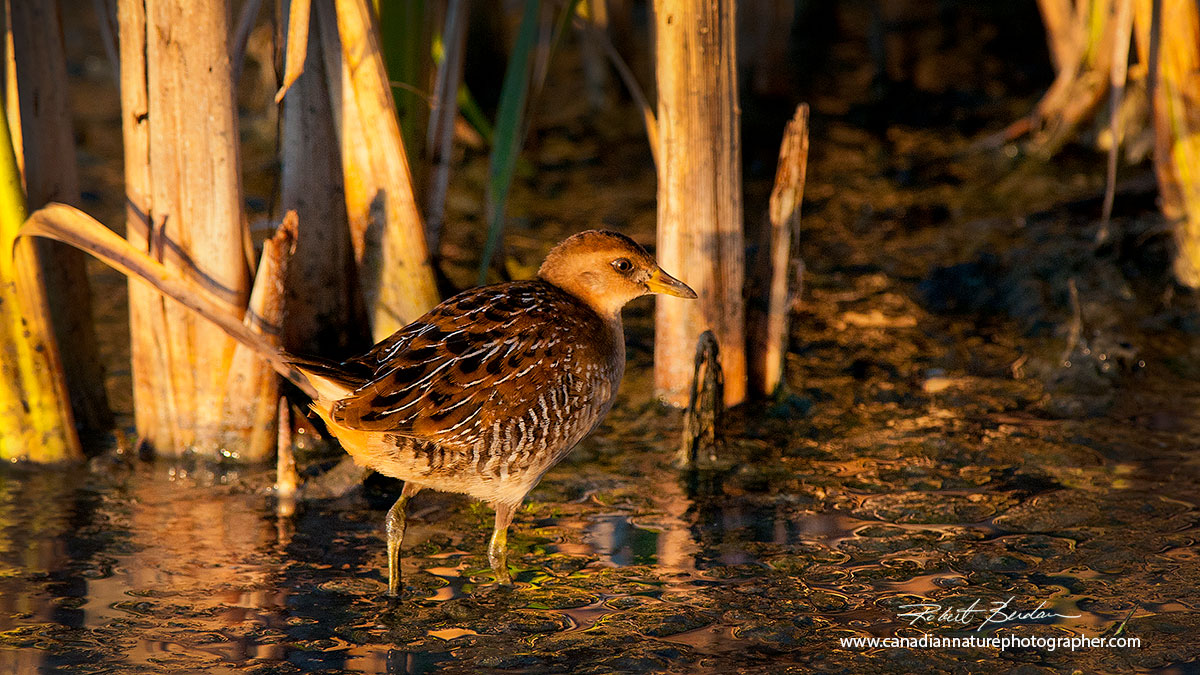
Sora photographed in early morning light at Weed Lake, AB. Nikon 300 mm F2.8 lens.
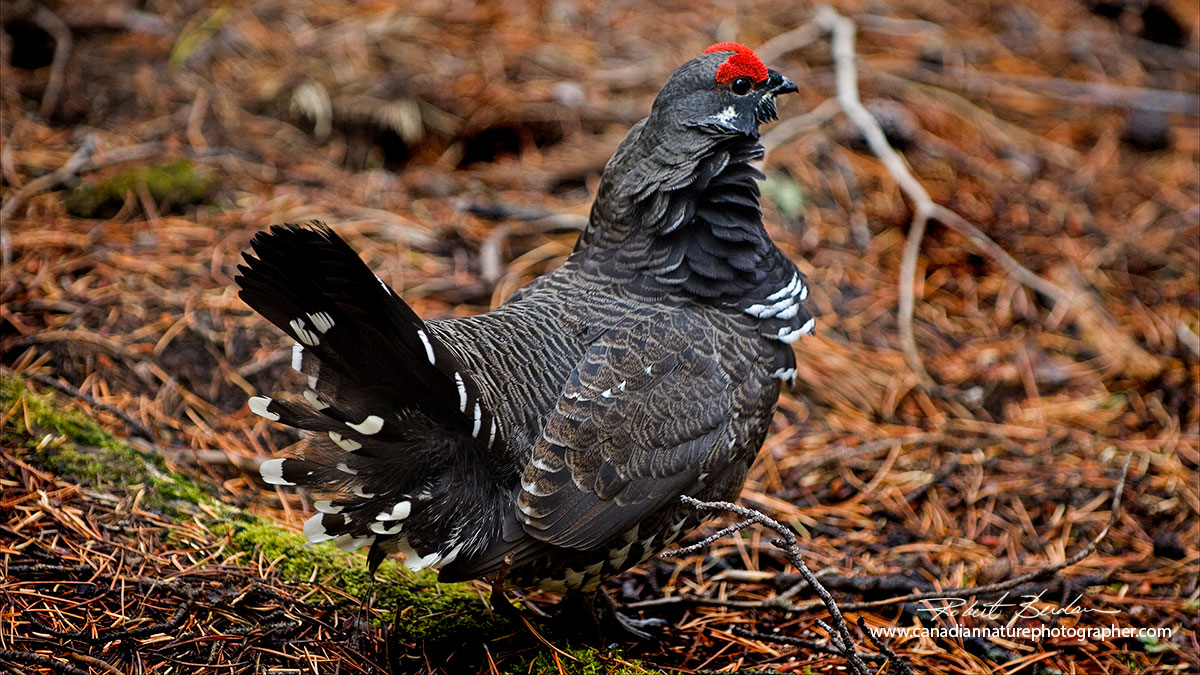
Male Spruce grouse are common in Kananaskis along the roads, some of them will hold still when you approach which is why they are sometimes called a "Fools hen". Nikon 70-200 mm F2.8 lens.

Male mountain blue bird photographed along the Sibbald Creek road into Kananaskis. Nikon 500 mm F4 lens.
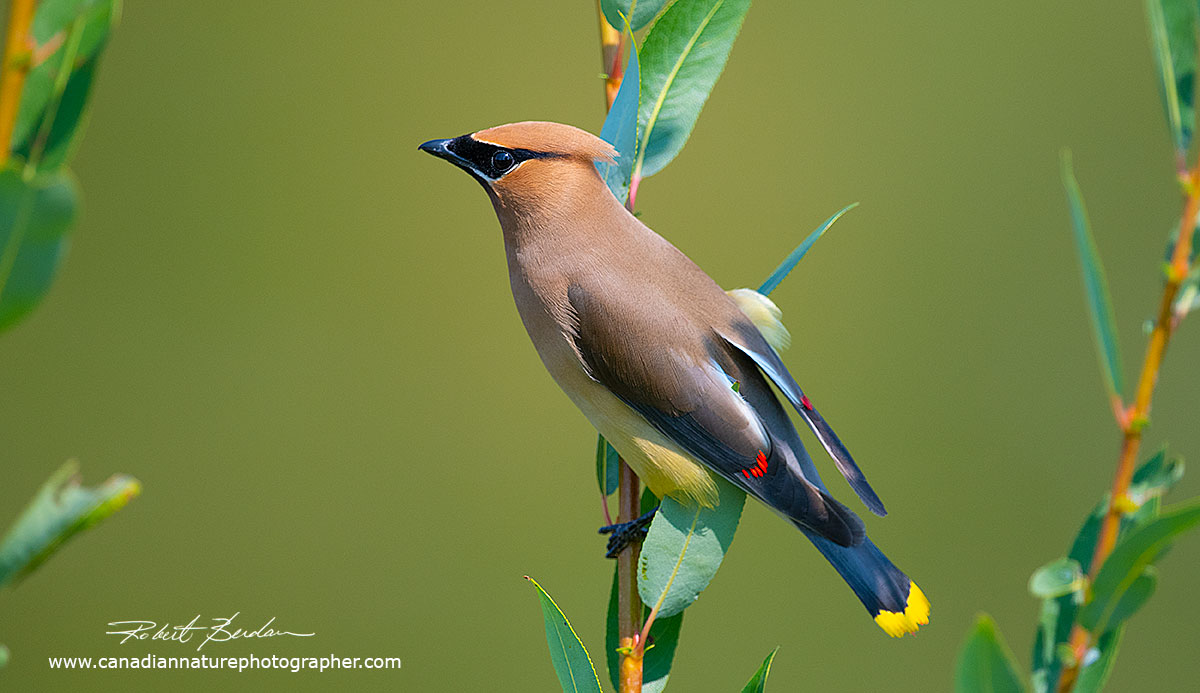
Cedar Waxwing. Bowmont Park in Calgary. Nikon 500 mm F4 lens.
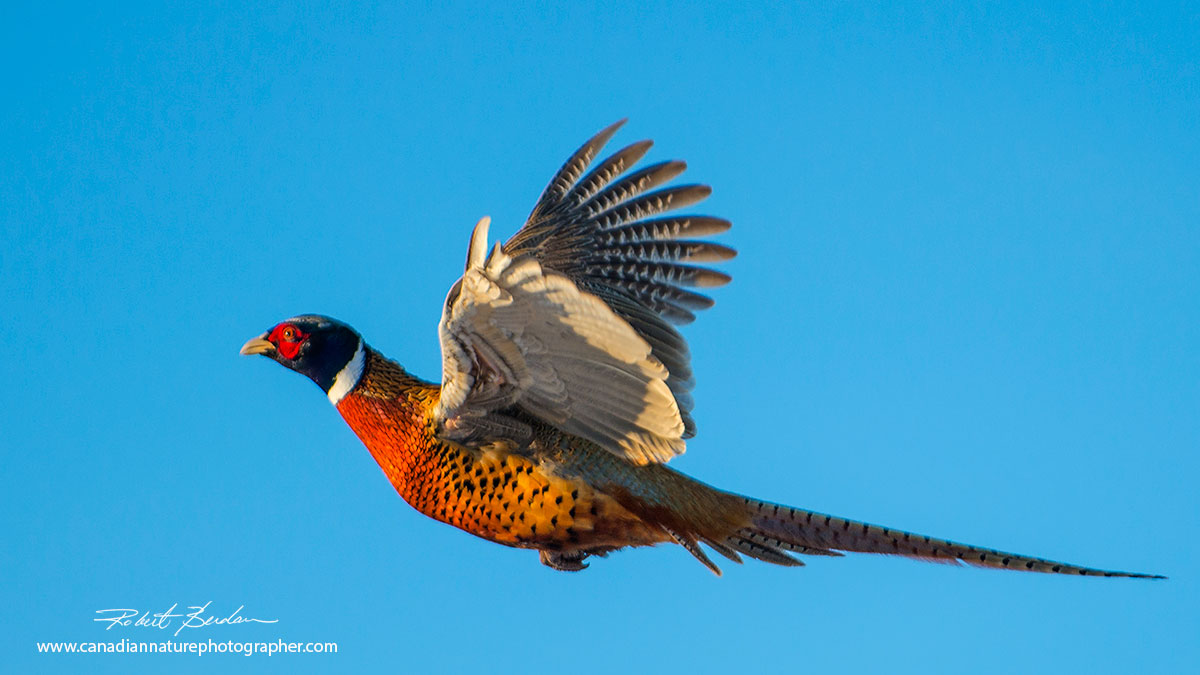
Ring-necked Pheasant in flight photographed near Dinosaur Provincial Park. Nikon 70-200 mm F2.8 lens
Photographic Equipment
Almost any camera today can take good photos even cell phones. If you want higher quality, images and be able to capture closeups of the animals, especially birds, you will need a telephoto lens. More folks are bringing compact cameras with wide zoom range lenses e.g. 18-300 mm lens or more. These compact cameras and lenses are ideal for travel, but often they don't focus quickly and if you want to capture smaller, shy birds, or birds in flight, these compacts may not be fast enough. Digital single lens reflex cameras are the still the best in my opinion though the smaller mirror less cameras are becoming more popular. I still prefer to look through the lens instead of focusing on a LCD (liquid crystal display) screen which often shows "jitter" when panning and the clarity of the image is not as great in my opinion.
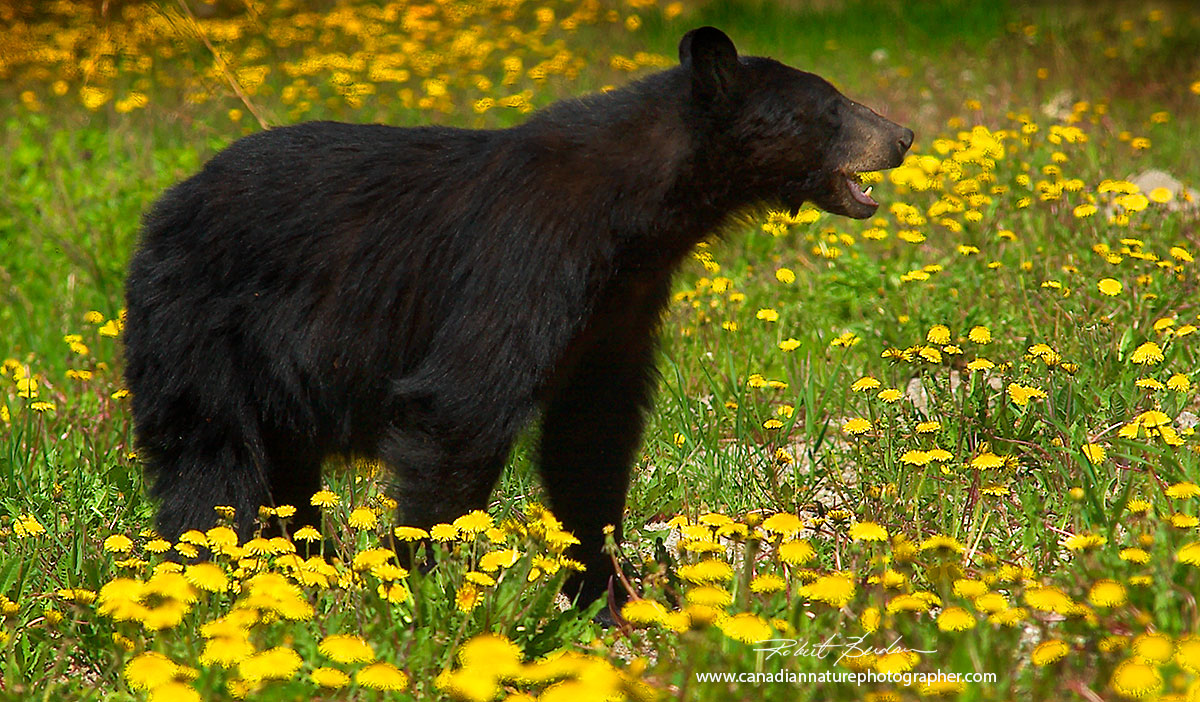
Black bears are commonly seen next to the road in most of the National Parks. Black and Grizzly bears like to feed on the dandelions. Nikon 70-200 mm F2.8 lens.

Typical bear jam in Banff National Park. You should stay in your car when viewing a bear up close, keep children in the car, don't try to pose or take a selfie with the bear, and watch for other cars that are looking at the bear and not paying attention to people or other cars. It's amazing how common sense disappears when folks get in a bear crowd.
Choice of camera for Wildlife
I don't shoot film anymore and haven't for years because there is just too many advantages of using a digital camera. When it comes to cameras my first choice is a Nikon DSLR (Digital Single Lens Reflex), I also own some canon cameras and lenses. Both brands are popular and offer a wide range of lenses. Sony brand cameras have also become popular and the offer excellent cameras though not the wide range of lenses as Nikon and Canon. Pentax, Olympus, Lumix, Zeiss, Leica are also popular choices. Any good photographer will tell you that the photographer is more important then the equipment, that being true, equipment still is important. If you want to photograph small birds you will need to get close or use a longer telephoto lens e.g. 500 mm focal length. If you want to photograph bears you will also need a longer lens for safety. To shoot from your car window you can use a wide variety of window mounts or bean bags to stabilize your camera. Make sure you pull way over to the side of the highway so you are not blocking traffic. If there is a crowd, consider driving on and photograph the next animal. You can often avoid crowds by simply getting up very early to visit the parks!

Bull moose photographed in Kananaskis beside the road. I see moose about 50% of my visits into Kananaskis. They are common along the Spray lakes road and around the upper lakes in Peter Lougheed park throughout the year. Nikon 300 mm F2.8 lens.

Moose in a meadow next to Upper Lakes in Kananaskis in autumn. Nikon 70-200 mm F2.8 lens.
Before you visit Alberta do some home work, find out as much as you can about the animals or places you intend to visit. For landscapes look for books by George Brybycin who photographed in the Rockies for over 50 years. For wildlife of any kind search for books by Dr. Wayne Lynch - a friend who has photographed in Alberta for over 30 years and all around the world. He is an expert on all critters and his books are informative and a pleasure to read.
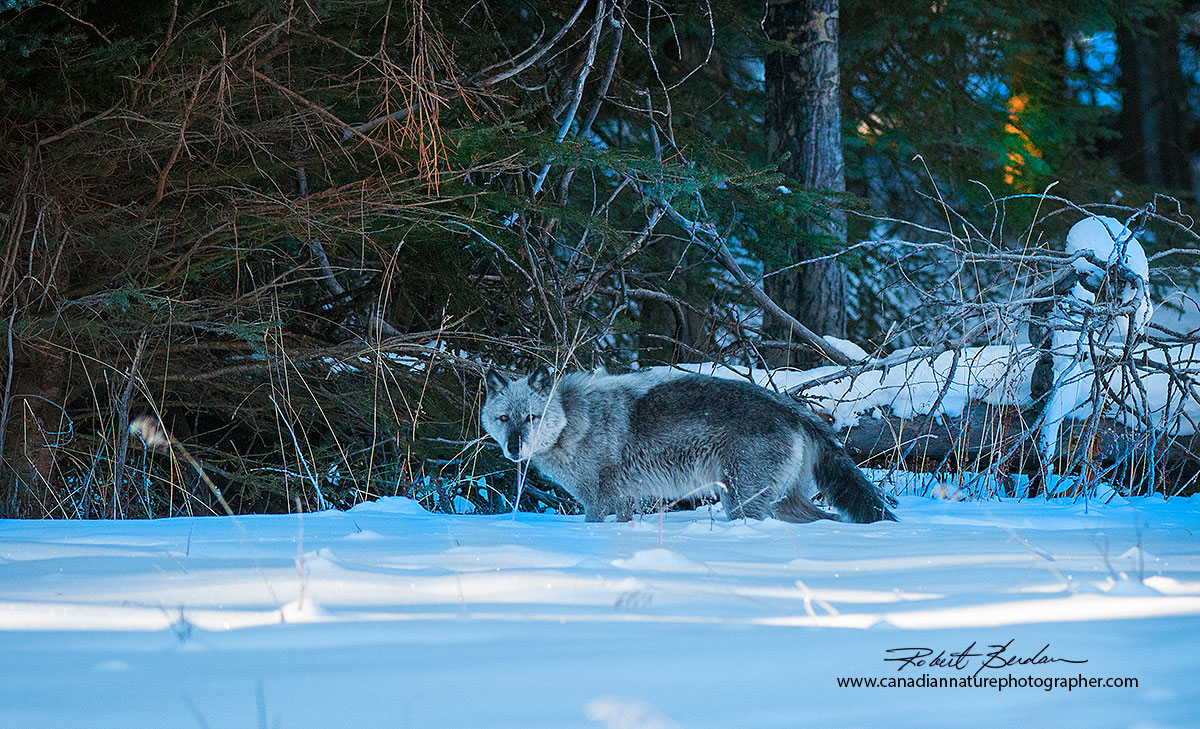
Wild wolf photographed along highway 1A Banff National Park. Three other photographers in my car did not get a single photo of this wolf because they were not prepared to shoot quickly. Nikon 300 mm F2.8 lens.
Tips for Photographing Wildlife
1. Leave early in the morning, in summer that might mean 4:00 am - I find more wildlife next to the roads in the early mornings.
2. Have your camera on your lap if not driving - have your telephoto lens on the camera, and have all your settings ready to shoot on short notice. I have had lots of folks with me that missed opportunities because they weren't ready. Wildlife may appear for only a few seconds sometimes.
3. I recommend a 70-200 mm or 100-300 mm lens attached to your camera for most wildlife in the mountain parks. Longer lenses are good for birds and bears.
4. With birds try to have a fairly fast shutter speed of 1\500 sec or better for hand holding. If you have a VR (vibration reduction) or IS (image stabilization) lens have this feature turned on when hand holding.
5. Have your telephoto lens set to its widest opening to have the fastest shutter speed.
6. A tripod is good for landscapes and for wildlife when shooting in low light, be sure to have a tripod that is appropriate size for the long lens you are using. Alternatively consider using a monopod - I keep both a tripod and monopod in my vehicle at all times.
7. Wildlife isn't always where it is supposed to be, so be prepared mentally to photograph something else e.g. flowers, mushrooms, landscapes, or waterfalls in addition to looking for wildlife. Or try a new photo technique, move your camera during long exposures, try multiple exposure, time lapse, shoot in Black and white, or shoot some video with your camera.
8. There is no such thing as bad weather for photography in my opinion. You can can get great shots in any kind of weather and frankly I seek out bad weather as it ads mood to the photos. Sunny days in my opinion make great post card photos, but I prefer interesting light and unusual weather.

Grizzly bear photographed with a Nikon 300 mm F2.8 lens from my car window. This bear was walking along the David Thompson highway near Saskatchewan crossing, Jasper National Park.
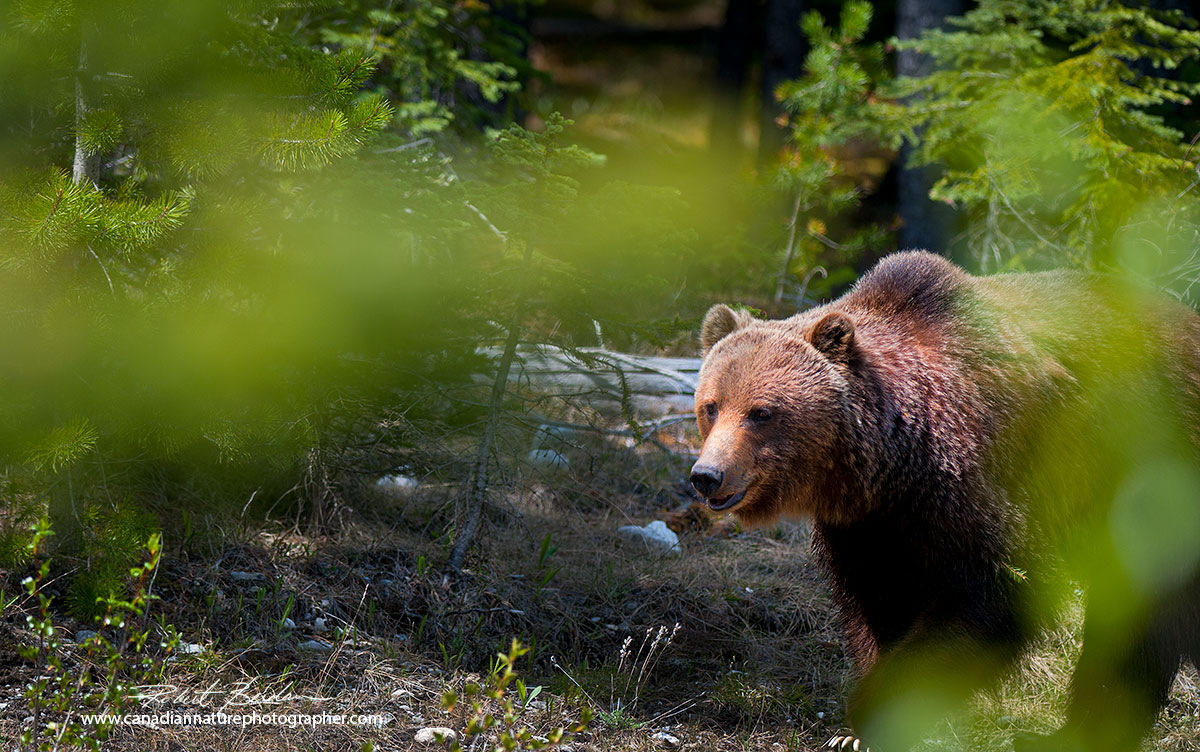
Another grizzly bear along the Jasper Highway I photographed from the safety of my car. Nikon 300 mm F2.8 lens.

This grizzly bear was next to the road in the Spray lakes area of Kananaskis. He was carefully turning over stones looking for food. Nikon 70-200 mm lens.

In the south part of Alberta along the Montana Border Pronghorn antelope are common. Nikon 500 mm F4 lens.
As a professional photographer I have learned that I won't have opportunities to take great pictures every time I go out to shoot. Some days I get skunked, and then other days I am very lucky. I have learned that when what I am looking for doesn't appear, I try to keep my eyes open for other opportunities. Keep your options open and don't put too much pressure on your self - sometimes you just need to enjoy the journey or outing. I usually find that if I am photographing from early morning until evening - I will usually get at least one or two good opportunities. A good photo can be taken in a fraction of a second, but finding that photo can take a lot of time. The more time you spend with your camera in the field the luckier you will become. I also remind myself that a bad day in the field is often more enjoyable then a day in the office.
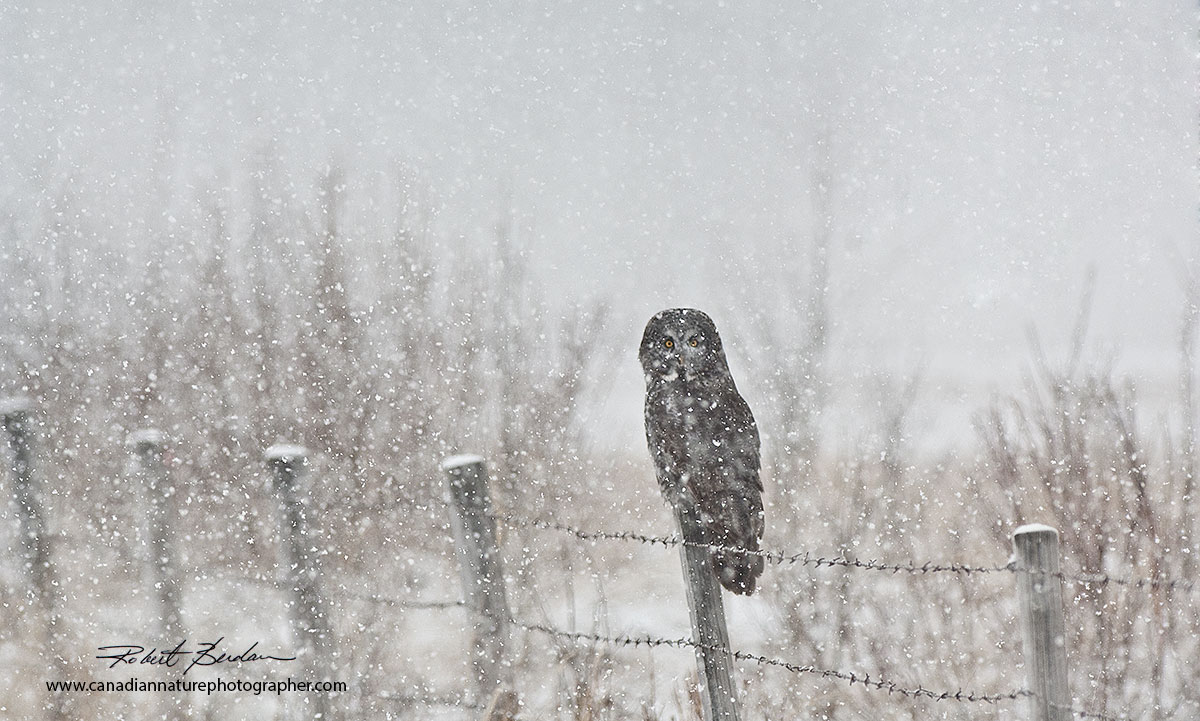
The above photo is one of my favourite wildlife images because of the falling snow. I was returning from Waterton with friend Hälle Flygare when we saw this Great Gray Owl on the fence post next to the road near Bragg Creek. We stopped and started photographing the owl, but when I checked the images on the back of my camera none of them were in focus because of the snow. I switched to manual focus and was able to get a few sharp pictures before the owl flew off. Lesson learned - check you images on the LCD on the back of your camera to ensure you are getting what you expect. Nikon 70-200 mm F2.8 lens.

Great Gray Owl in flight photographed near Millarville, AB Nikon 300 mm F2.8 lens.

Great Gray Owl photographed next to Grande Valley road. AB Nikon 300 mm F2.8 lens.
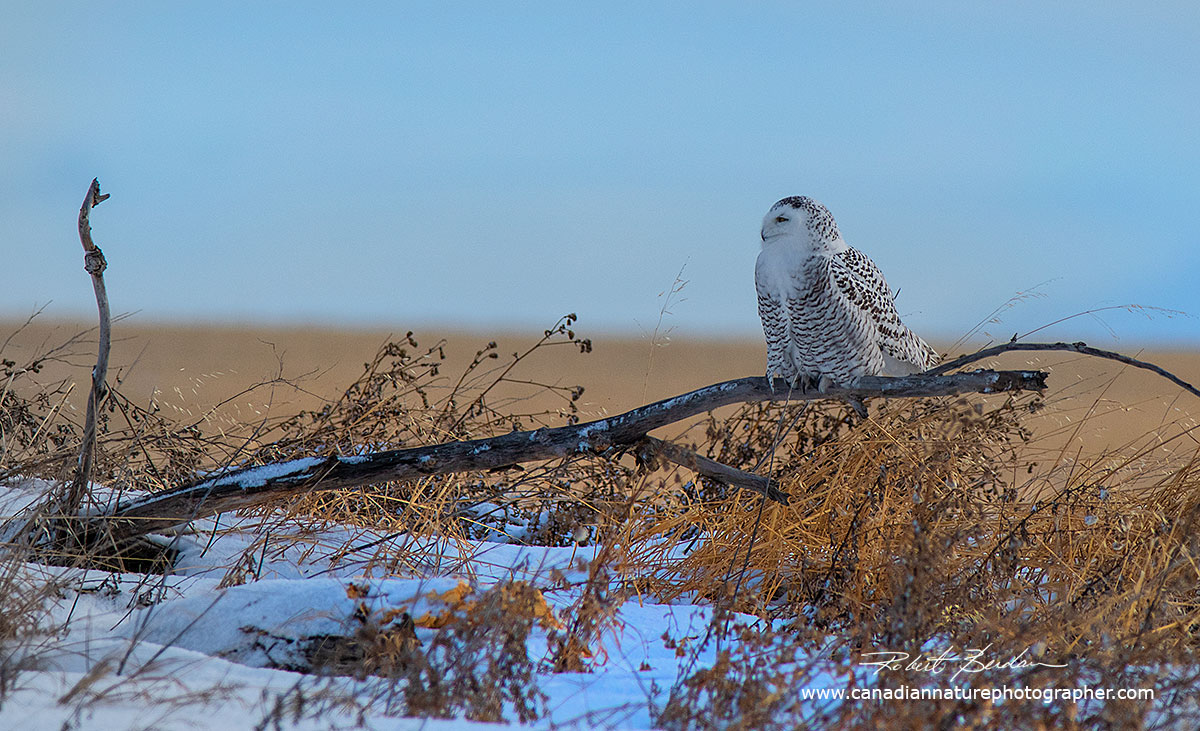
Female Snowy Owl with heavy barring on the prairies east of Calgary. Nikon 500 mm F4.

Above is a male Snowy Owl in flight. Snowy owls appear around November and stay until the end of February, sometimes a few weeks longer depending on the weather. I lead snowy owl tours in the winter and on my best day I have spotted 14 owls. On average I see about 1 owl per 100 km of driving the back roads.
A good place to photograph birds near Calgary is Frank Lake. In March the tundra swans gather on the ice for their trip further north. In June you can find a wide variety of waterfowl and the unusual White-faced ibis that looks like it belongs in the tropics.
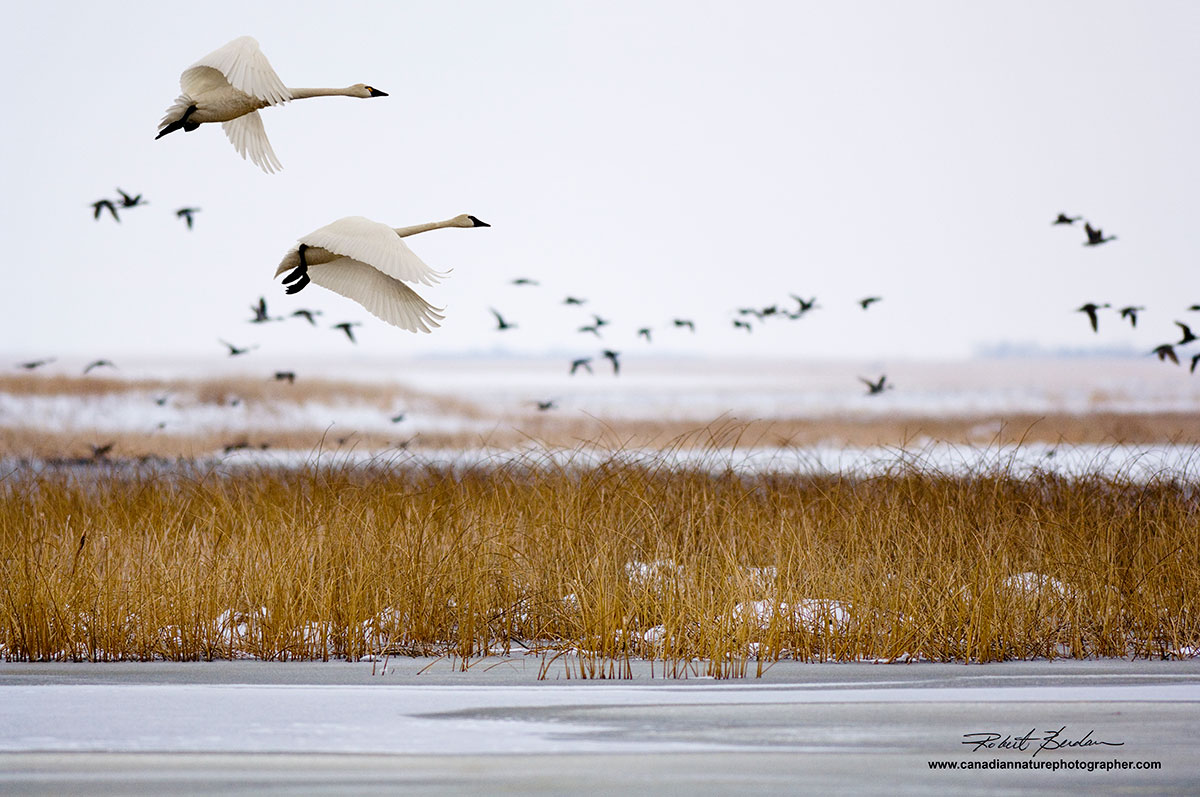
Tundra swans in flight over Frank Lake in mid March. Nikon 300 mm F2.8

White-faced ibis flying over Frank Lake in June. Nikon 300 mm F2.8 lens.
On average it takes me about 100 photos to get one good one, about 1000 to get a really good one, and about 5,000 to 10,000 shots to get what I call a winner. So keep these numbers in mind when you are shooting. Take lots of shots and edit ruthlessly. I tend to keep all my photos since the cost of storage is cheap - an 8 TB hard drive will hold several hundred thousand images and costs about $250. I keep all my images for two reasons: 1) I use the bad photos for teaching 2) sometimes a photo that at first didn't appeal to me may look better after viewing it a few weeks or months later. The main disadvantage of my approach is that I have to look through a lot more photos to find the ones I want. I think the biggest factor in having success with wildlife photography is the amount of time you spend in the field with your camera. The more time you are out with your camera the luckier you get. RB
Authors Biography & Contact Information
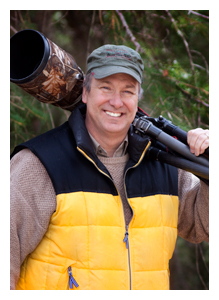 Bio: Robert Berdan is a professional nature photographer living in Calgary, AB specializing in nature, wildlife and science photography. Robert retired from Cell\Neurobiology research to take up photography full time years ago. Robert offers photo guiding and private instruction in all aspects of nature photography and Adobe Photoshop training - including photomicrography, macrophotography.
Bio: Robert Berdan is a professional nature photographer living in Calgary, AB specializing in nature, wildlife and science photography. Robert retired from Cell\Neurobiology research to take up photography full time years ago. Robert offers photo guiding and private instruction in all aspects of nature photography and Adobe Photoshop training - including photomicrography, macrophotography.
Email at: rberdan@scienceandart.org
Web site: www.canadiannaturephotographer.com
Phone: MST 9am -7 pm (403) 247-2457.
Click on the buttons below and share this site with your friends